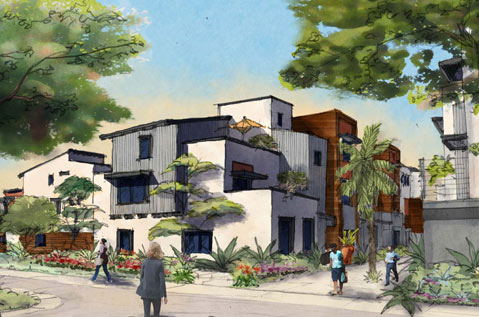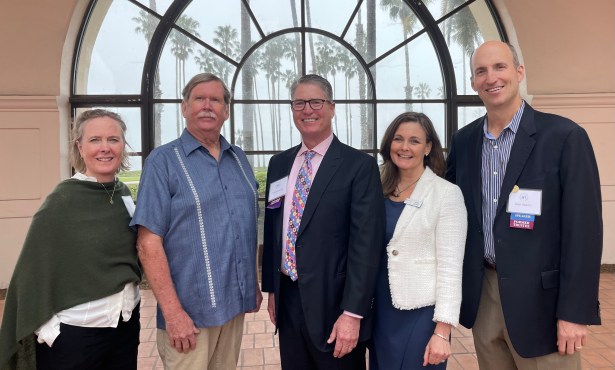Goleta’s City Council and Growth
Councilmembers Control the General Plan

Few people realize that not one of the five current Goleta City Council members faced opposition to win his or her current term. Here’s how this curious and unprecedented condition happened: Councilmembers Michael Bennett, Roger Aceves, and Paula Perotte were unopposed in their 2014 elections; Councilmember Jim Farr was unopposed in 2012; and Councilmember Vallejo was appointed in July 2014 to fill the seat of resigning councilmember Ed Easton.
Different theories have been suggested for why these councilmembers ran with no competition. One theory is that the candidate shortage is based on a belief that it doesn’t matter who is on Goleta’s Council. Some have believed claims that all Goleta development is dictated only by the city’s General Plan and that city councilmembers have no role or power in determining Goleta’s development. But a review of how development happens here demonstrates the very opposite.
Yes, Goleta has a General Plan that outlines what development might happen over a 20-year period. But, in fact, much of what and how development is approved is largely controlled by Goleta’s City Council because the General Plan is just that, general. It is a high level outline, not a detailed design or a blueprint. (See Government Code Section 65300-65303.4.)
The General Plan does not examine and approve each project’s design, compatibility with the neighborhood, conformance with zoning, and impacts of concern and possible mitigations in each project’s Environmental Impact Report (EIR). Nor does the General Plan contain any schedule for pacing development, determining whether the community can support each project at the time it’s proposed — is there enough water, transportation systems, etc.? Is there funding for the infrastructure to support the project?
So if these details are not in the General Plan, who is responsible for determining what and when development gets built in Goleta? How did approval happen over a fairly short period for more than 1,000 housing units at Hollister Village (Westar), Villages at Los Carneros, and Old Town Village? How were two more hotels on Hollister, the Rincon Palms Hotel and the Marriott Residence Inn, recently approved? The answer is that the responsibility for approving (or denying) each project rests directly or indirectly with Goleta’s City Council.
A development proposal starts with Goleta’s Planning staff who do the initial evaluation and direct the developer through the application process. City staff work for the Director of Planning who is hired by Goleta’s City Manager. Who appoints the City Manager? Goleta’s City Council.
A project then moves along to Goleta’s Design Review Board (DRB). The DRB reviews the project’s architectural and landscape design, assesses neighborhood compatibility, and hears public comments. Who appoints DRB members? Goleta’s City Council.
Then the project moves on to the Goleta Planning Commission (PC), which reviews the project’s environmental analysis of impacts and mitigations for those impacts, and also hears public comments. Who appoints the PC members? Goleta’s City Council. And where must the public go to appeal PC decisions? Goleta’s City Council.
And suppose a project isn’t in the General Plan? Who has the power to grant developer requests for changes or exceptions to Goleta’s General Plan — change the current zoning, make the project bigger, exceed the General Plan’s height limitations, reduce the required setbacks from sensitive areas or reduce the parking requirements? The answer is that at any regular City Council meeting, by a 3-2 vote, Goleta’s General Plan can be changed by Goleta’s City Council.
In 2006, with the backing of the Goleta Chamber of Commerce, three new councilmembers were elected, claiming that the Plan needed “fixes” and “tweaks for more flexibility. The new majority significantly amended Goleta’s General Plan in 2008, contrary to testimony from most community members. The sweeping amendments primarily gave the council and staff more power to interpret and amend the General Plan.
Since then the General Plan has been repeatedly amended. For example, in 2010 the new majority changed the requirement of keeping development at least 100 feet away from creeks and sensitive areas, giving themselves the discretion to reduce the setback to only 50 feet. They immediately used this “flexibility” to approve units set back less than 100 feet from the creek in Haskell’s Landing (renamed “The Hideaway”) on Hollister.
Most recently, in October 2015, council amended the General Plan by a 3-2 vote in order to approve the 175-unit Old Town Village Project. Poof! Twelve acres of land zoned in the current General Plan for “Visitor Serving” were instantly rezoned “Residential,” and the development was approved. Done.
Some claim that Goleta’s recent approval of over 1,000 housing units was required to meeting California’s Regional Housing Needs Assessment (RHNA) quotas for housing. But in fact California requires only that cities’ Housing Elements contain zoning for a specified number of housing units. Cities are empowered to balance housing needs with community guidelines, especially to ensure that impacts and their mitigations are accounted for.
According to California’s Regional Housing Needs Assessment (RHNA) guidelines:
“Housing element law recognizes the most critical decisions regarding housing development occur at the local level within the context of the periodically updated general plan. The RHNA-Plan component of the general plan requires local governments to balance the need for growth, including the need for additional housing, against other competing local interests.” (Emphasis added.)
As this language states, Goleta’s City Council can deny developments that conflict with key local concerns such as traffic, views, environmental considerations, and water supply. California’s housing quotas are not responsible for the approval of 1,000 housing units virtually all at once, Goleta’s City Council majority is.
Whether you like or dislike Goleta’s recent development boom, two conclusions are very clear. First, the responsibility for development lies primarily with Goleta’s city council majorities past and present. Second, residents share responsibility for development because we elect our city council. Those complaining about Goleta development might consider the words of cartoon character Pogo who famously observed, “We have met the enemy and he is us.”
In November 2016 two council seats will be up for election, those of councilmembers Farr and Vallejo. Councilmember Vallejo has already announced he is running. It remains to be seen whether additional candidates will emerge to give voters the opportunity to change Goleta’s growth trajectory (see Goleta’s current cumulative projects list: http://tinyurl.com/zyskcmw ). Whatever happens, the outcome is up to all of us, the residents of Goleta.



